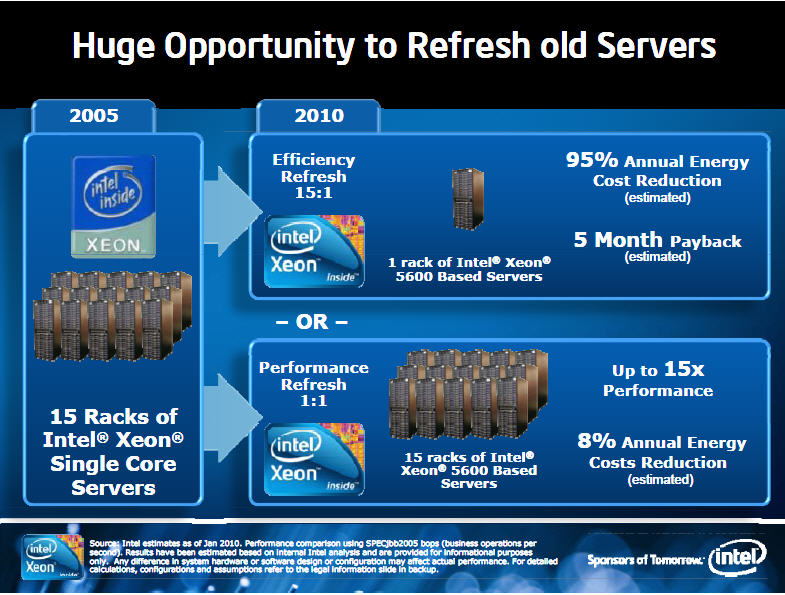Will Intel's latest Xeon lineup be an 'economic no brainer'?

Intel launched its latest server chips designed for next generation data centers Tuesday and is pitching a five month return on investment for customers using single core servers---a third of the customer base---and a 15 month payback for more modern machines.
The chip giant's challenge: Position its latest server chips---the Xeon 5600 family---as an "economic no brainer" for customers that have been putting off server upgrades. The single core crowd can get a 15:1 server consolidation ration with the latest Xeons. Intel's positioning is worth noting as research firms and vendors have been preaching that a server upgrade cycle is about to break out. But first, the details. Boyd Davis, general manager Intel's data center group marketing, broke out a blitz of performance enhancements and noted that upgrading was an "economic no brainer." To wit (statement):
- The Xeon X5670 has up to 40 percent better performance per watt at the same speeds as its X5570 predecessor.
- The server family has two new security features---Advanced Encryption Standard New Instructions (AES-NI) and Trusted Execution Technology (TXT)---to enable better security for virtualized environments. The technology is essentially an effort to provide a better foundation for cloud computing security. AES-NI accelerates performance for database encryption, full disk encryption and secure Internet transactions. TXT provides protection for applications that move between virtual servers.
- The Xeon 5600 series supports up to six cores per processor and has a 60 percent performance improvement over the 5500 series. The frequency-optimized quad-core version of the Intel Xeon processor 5600 series peaks at 3.46 GHz with a TDP of 130 watts, while the six-core version reaches 3.33 GHz with a TDP of 130 watts. Advanced six-core versions will top out at 2.93 GHz and TDP of 95 watts, and the standard quad-core processor will reach 2.66 GHz at 80 watts.
- The pricing of the 5600 is "effectively the same" as the 5500, said Boyd. The Intel Xeon processor 5600 series ranges in price from $387 to $1,663 in quantities of 1,000. The E5645, L5638 and L5618 embedded processors are priced at $958, $958 and $530, respectively, in quantities of 1,000.
- Cisco, Dell, Fujitsu, HP, IBM and Oracle will have systems based on the Xeon 5600 lineup.
While all of that is impressive, the server upgrade cycle comes down to the money and whether the bean counters will buy in. That follow the money approach is why Intel was pitching its ROI case.
Now those surface claims only go so far. Here's a look at the footnotes and calculations---enough to get you started on due diligence---for the 5 month ROI claims:
And the 15-month payback claims:
Meanwhile, the underdog in this server refresh cycle is AMD. AMD is planning a server platform refresh in the next few weeks and is focusing on the volume x86 market. The plan is to segment the market into high-end and low-end applications and focus on value.
